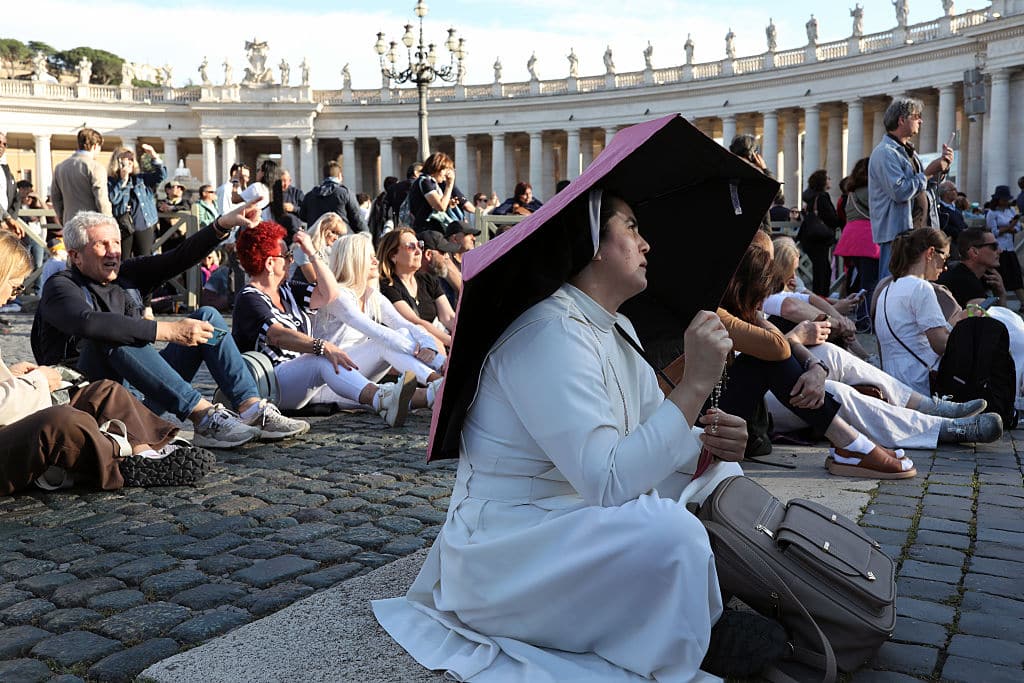Fittingly for what some are calling the first "<a href="https://www.telegraph.co.uk/news/2025/05/04/first-clickbait-conclave-everyone-will-follow-pope-catholic/"><mark style="background-color:rgba(0, 0, 0, 0)" class="has-inline-color has-vivid-cyan-blue-color">clickbait conclave</mark></a>”, the Vatican is providing a live footage feed of St Peter's Square.
It means that wherever you are in the world, despite the 133 cardinal-electors being sealed off from the world in the Sistine Chapel, you can follow the ballots of their votes by watching for smoke coming from the chimney on top of the famous chapel – which sits to the right of St Peter's Basilica as you look at the front of the basilica – that signals whether a new pope has been elected.
The signal of black smoke – <em>fumata nera</em> – serves to show that the cardinal-electors have failed to elect a new pope in the latest ballot of the conclave.
Black smoke billowing from the chimney indicates that no decision has been reached and that the required two-thirds majority hasn’t been achieved to find a successor to Pope Francis, who died on Easter Monday, 21 April, at the age of 88 years old.
Once white smoke emerges that will be the signal that the next leader of the world’s 1.4 billion Catholics and the 267th pope has been chosen.
The following ballot burning times are given as rough estimates for Thursday 8 May and Friday 9 May:
<em>First ballot</em><br>Rome — 10:30<br>London — 09:30
<em>Second ballot</em><br>Rome — 12:00<br>London — 11:00
<em>Third ballot</em><br>Rome — 17:30<br>London — 16:30<br><br><em>Fourth ballot</em><br>Rome — 19:30<br>London — 18:30
Smoke will only appear after the first and third ballots if a pope has been elected. Otherwise, after every two rounds, the cardinals’ ballot papers, on which they write the name of the person they want elected pope, are burned in one of two special stoves installed inside the Sistine Chapel for the conclave, with black smoke emitting after the second and fourth ballots.
<em><strong>Saturday 10 May 2025</strong></em>
If no candidate has been elected, then this day will be set aside for prayer and reflection. The last time a conclave lasted more than three days was 1958, when John XXIII was elected on the fourth day of the conclave, though there had been no ballot on the first day. The other outlier during the 20th century was the election of Pius XI in 1922, which took five days, though there was again no ballot on the first day.
<em><strong>Sunday 11 May – Tuesday 13 May</strong></em>
Following a day of prayer and reflection, the 133 cardinals will vote in seven more ballots following the same rough schedule given above, after which, if there is still no successful candidate, the conclave will break for another day of prayer and reflection.
<strong><em>Wednesday 14 May onwards</em></strong>
The cardinals will vote in up to 18 more ballots, again following the same rough schedule given above, until a candidate receives two-thirds of all votes cast. If there is still no winner, a run-off between the two top candidates will be held until one of them receives the required majority.
<a href="https://thecatholicherald.com/taking-on-personal-responsibility-for-1-4-billion-souls-the-spectacle-gripping-the-world/"><mark style="background-color:rgba(0, 0, 0, 0)" class="has-inline-color has-vivid-cyan-blue-color"><strong><em>RELATED: Taking charge of 1.4 billion souls: the spectacle gripping the world</em></strong></mark></a>
<em>Photo: People gather in St. Peter's Square during the first day of conclave, Vatican, 7 May 2025. (Photo by Marco Di Lauro/Getty Images.)</em>



